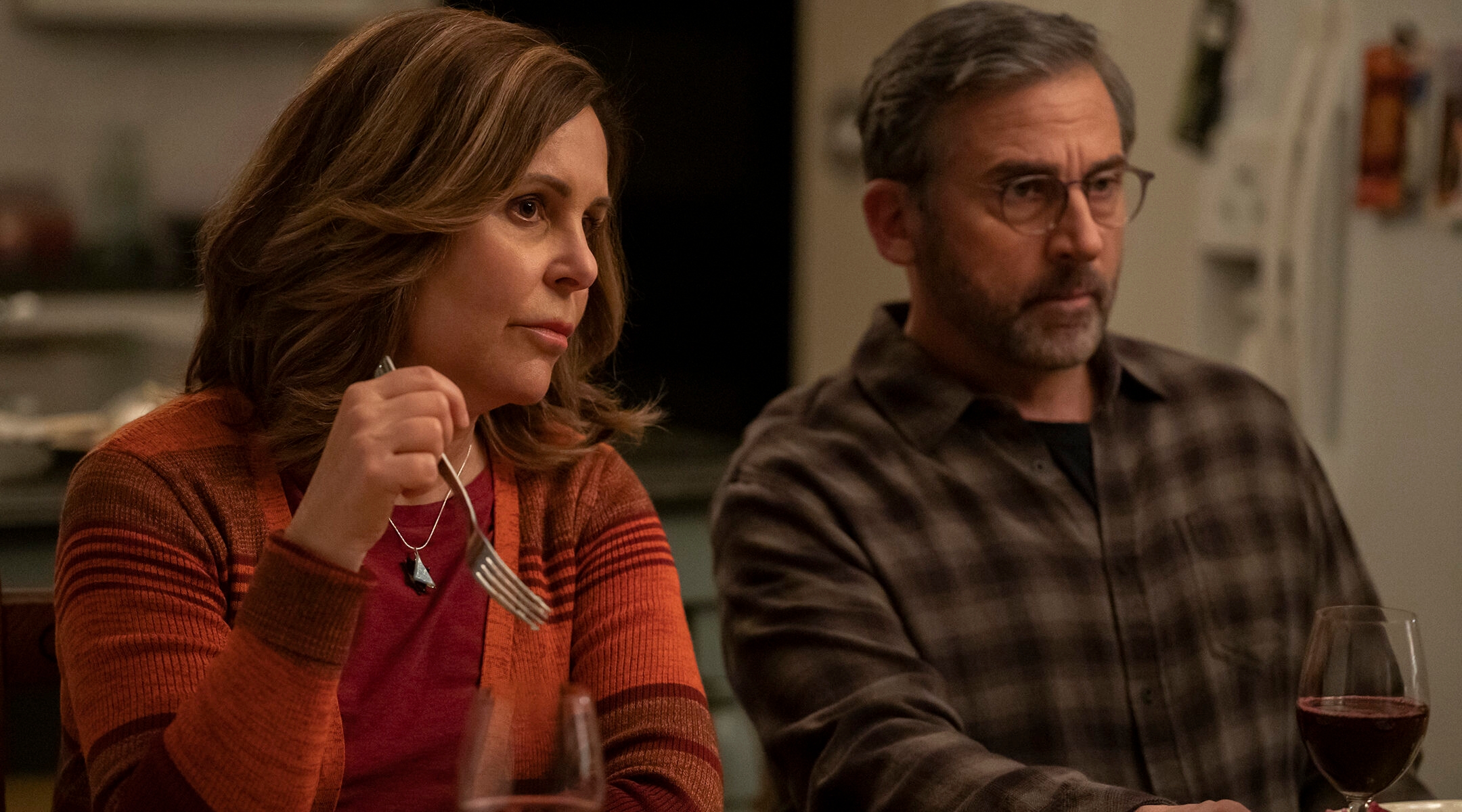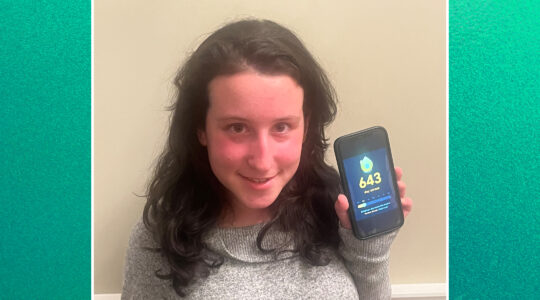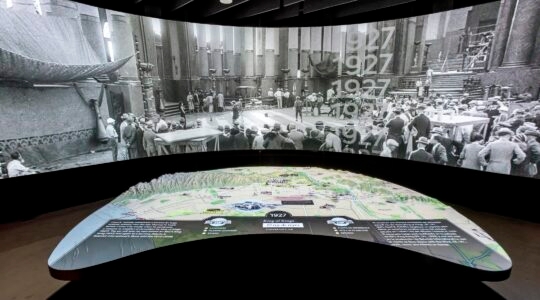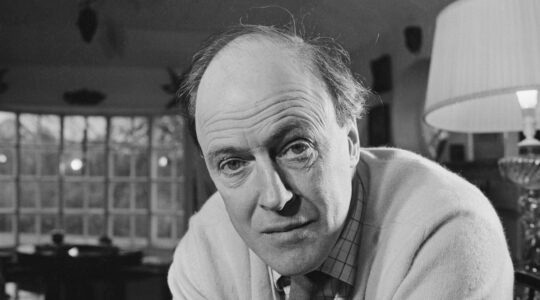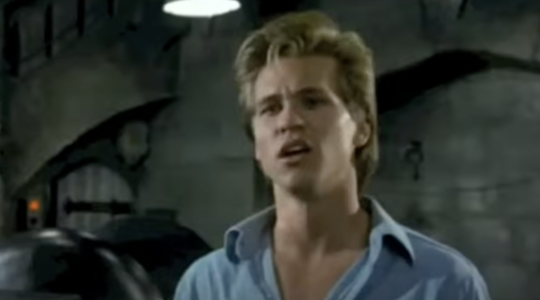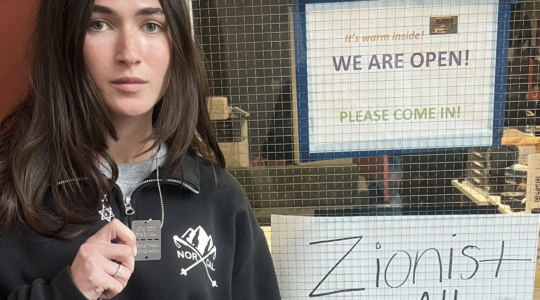(JTA) — Episode three of “The Patient,” the well-received psychological thriller series on Hulu about a serial killer who kidnaps his therapist, involves a flashback to an Orthodox wedding.
Ezra, son of the protagonist therapist Alan Strauss and Reform cantor Beth Strauss, is marrying an Orthodox woman named Chava. Guitar in hand, Beth sings “Dodi Li,” a traditional Jewish wedding song, knowing that women are not allowed to sing in the presence of men in this Orthodox community. As she performs, some men get up to leave. Ezra and his bride stay but look uncomfortable.
The moment gets at the tension that Ezra’s transition out of the Reform lifestyle of his upbringing and into Orthodoxy has wrought within the Strauss family. But the scene was not originally written this way.
Although the show’s creators Joel Fields and Joe Weisberg are both Jewish, they weren’t aware of the Orthodox prohibition against women singing in front of men and had first written the moment as a nice memory of a mother singing at her son’s wedding. The show’s consultant, Rabbi Menachem Hecht, a teacher at the Modern Orthodox YULA yeshiva high school in Los Angeles, informed the duo of the rule — which thrilled them because they said it made the scene more interesting and complicated. The final product got across the viewpoints of both denominations in a fair way, Hecht said.
“There’s definitely a way to run that scene where it just makes Orthodox Jews look anti-women and bigoted,” Hecht said. “The point wasn’t just to make them look bad. It was to show how there could be real tension here.”
The scene and the consultation behind it points to the level of Jewishness that Fields and Weisberg wove into the fabric of “The Patient,” which debuted on Aug. 30 and is still releasing weekly episodes on FX on Hulu through the finale on Oct. 25. The pair, who also created the acclaimed Cold War spy drama “The Americans,” have spoken at length about their Jewish backgrounds — Fields as the son of a Reform rabbi and Weisberg as the son of Reform parents who attended a Conservative Synagogue.
In “The Patient,” Alan — played by the non-Jewish Steve Carell, a casting choice they were asked to defend on a press tour — is a widower, having lost his wife Beth (Laura Niemi) to cancer. She was a cantor at a Reform synagogue and their son Ezra (Andrew Leeds) turned to Orthodox Judaism in college, a path that his parents didn’t understand. A deranged new patient named Sam (Domhnall Gleeson) kidnaps Alan in an attempt to cure his own murderous impulses. Part of Alan’s work with Sam is getting him to understand other viewpoints — just because someone says something that Sam doesn’t like or perceives as rude, it doesn’t mean they deserve to die.
“I think on some level consciously and on some level unconsciously, we were dealing with general and specific themes of intolerance, and it seemed interesting to explore the challenges of differences that from the outside might seem relatively small but from the inside seem like a chasm,” Fields told the Jewish Telegraphic Agency.
Fields and Weisberg don’t spend screen time educating the viewer on the intricacies of Orthodox practice that show up in the series. In another scene, Ezra, his sister and their families are having dinner at Alan and Beth’s house. Beth serves her daughter’s children ice cream as Ezra’s children look on, unable to partake, eating food they brought in Tupperware. The entire scene is less than a minute long, so the audience needs to understand quickly what is happening.
“We are not believers in exposition. We don’t want to spell it out. We used to joke on ‘The Americans’ that ‘who could understand this? We barely understand this.’ Nobody’s going to understand it, but as long as they feel it, that’s what’s good,” Weisberg said.
Fields and Weisberg worked with the production design and set decorating team to ensure that all the details were right, such as paper plates for Ezra’s family, who could not eat on the dishes that are normally used to serve unkosher food.
Though Beth’s actions in that scene might seem cruel to some, they fit the character of a woman who devoted her life to Reform Judaism.
Reform Rabbi Robyn Frisch, of Temple Menorah Keneseth Chai in Philadelphia, told the Jewish Telegraphic Agency that when her son turned to Orthodox Judaism at age 16, she felt rejected at first.
“We raised our kids we thought with this meaningful Jewish life. He never said it straight out, but there clearly things we did that were not what he wanted,” Frisch said.
She said her work with interfaith couples as the director of the Rukin Rabbinic Fellowship for 18Doors — a national nonprofit organization that helps interfaith couples and families — helped her eventually accept her son’s choices. She added that she wants to start a nonprofit like 18Doors for families with children who become Orthodox, to help them through the challenges and blessings of such a change.
“To be a Jew in America is to know a bunch of people who have gone through similar iterations of this sort of family dynamics,” Fields said.
In addition to the family divides, Judaism plays an important role in other aspects of the story. In one episode, Alan dreams of himself in the barracks of Auschwitz.
“It seemed obvious to us that a Jewish person locked in a guy’s basement facing death as Alan Strauss was would associate with that imagery,” said Weisberg. “We grew up with that imagery and that history really infused in our lives, in synagogue, in Sunday school, in our regular schools, and at home. Anybody tries to kill me, I’m going there.”
As Alan tries to teach Sam about empathy, so that he can start thinking of his victims as people and consider what their families need, he talks about Jewish rituals associated with death, including the Mourner’s Kaddish. The episode released this Tuesday is titled “Kaddish,” for the prayer that holds significant meaning to Fields and Weisberg.
“I remember my dad telling me about the Kaddish when I was very young. It’s not like he sat down and explained prayers to me, but I remember him saying that it was a prayer that began as students giving thanks for their teachers, and then it became something that we said to give thanks for everybody, for those who meant something to us in life,” said Fields. “And it was a prayer of thanks, not a prayer of loss, and that always stuck with me.”
Fields and Weisberg recorded versions of the prayer for Carell, who had to recite it in its entirety in the show.
“I loved being able to assure him that he sounded great when he was saying it, because in any American congregation, it’s not like there’s the right way,” Weisberg said. “Every Jew is saying it differently and pronouncing all the words differently, so he sounded a lot like me and everybody else I knew.”
When the pair first reached out to Hecht, he assumed that the main plot of the show revolved around Jewish themes.
“They put so much thought into it and so many resources into this Orthodox story, and I figured that was the show. And then when I finally saw the script I was like, ‘Wait, this isn’t the show at all, this is like a minute and a half of the show across the whole season,’” Hecht said. “I just thought this speaks to who these folks are who are putting this together and the degree to which they’re approaching this with a sense of respect and with seriousness and with rigor.”
Fields said it was a product of how deep their Jewish identities run.
“It’s been really meaningful to be able to tell a story that we hope is relatable to everybody, that we hope ultimately is about everyone’s common humanity and common experience, but is expressed through particular character dynamics that are just deep inside us culturally,” he said. “One doesn’t often get the chance to do that, so it means a lot.”
JTA has documented Jewish history in real-time for over a century. Keep our journalism strong by joining us in supporting independent, award-winning reporting.
